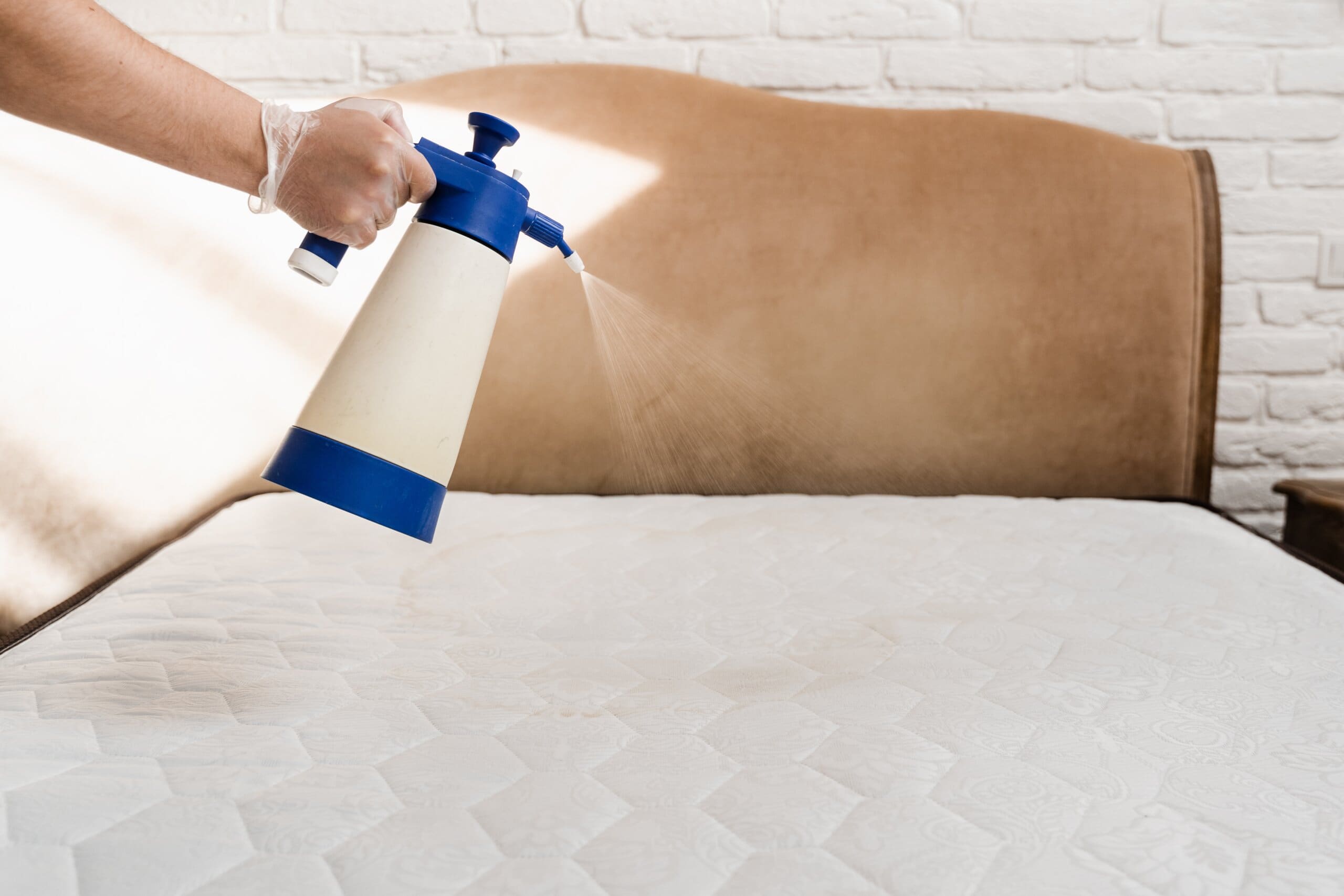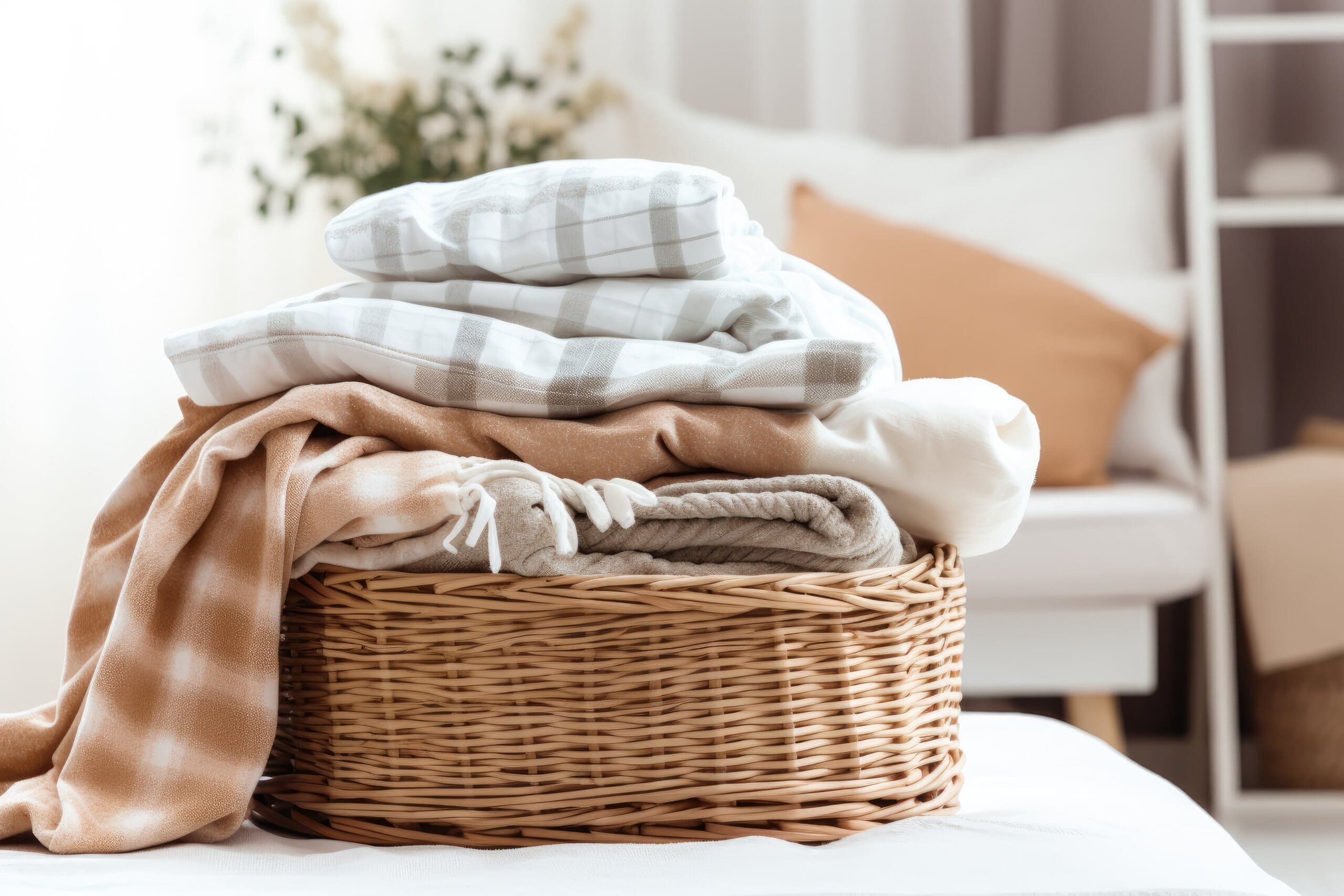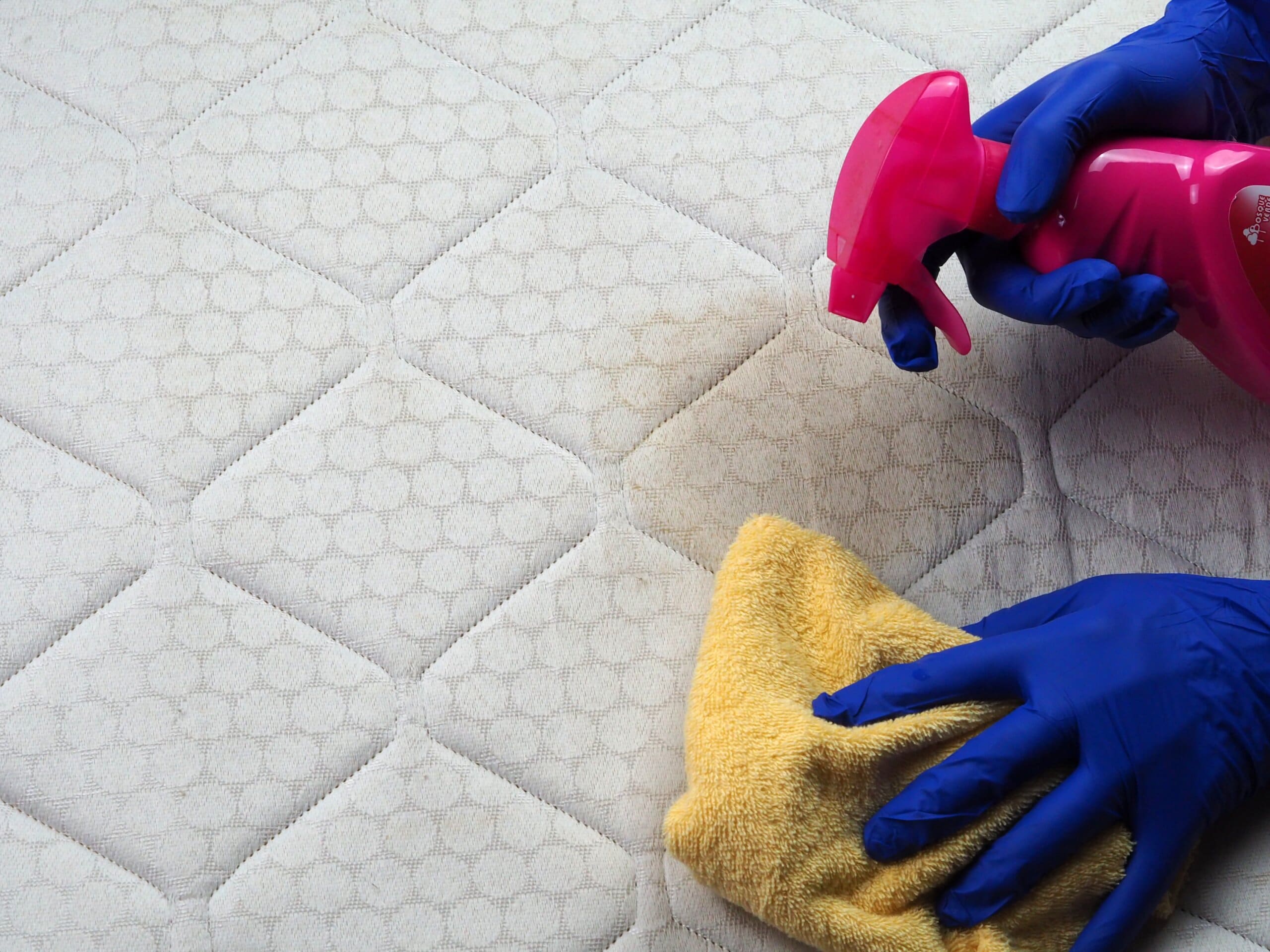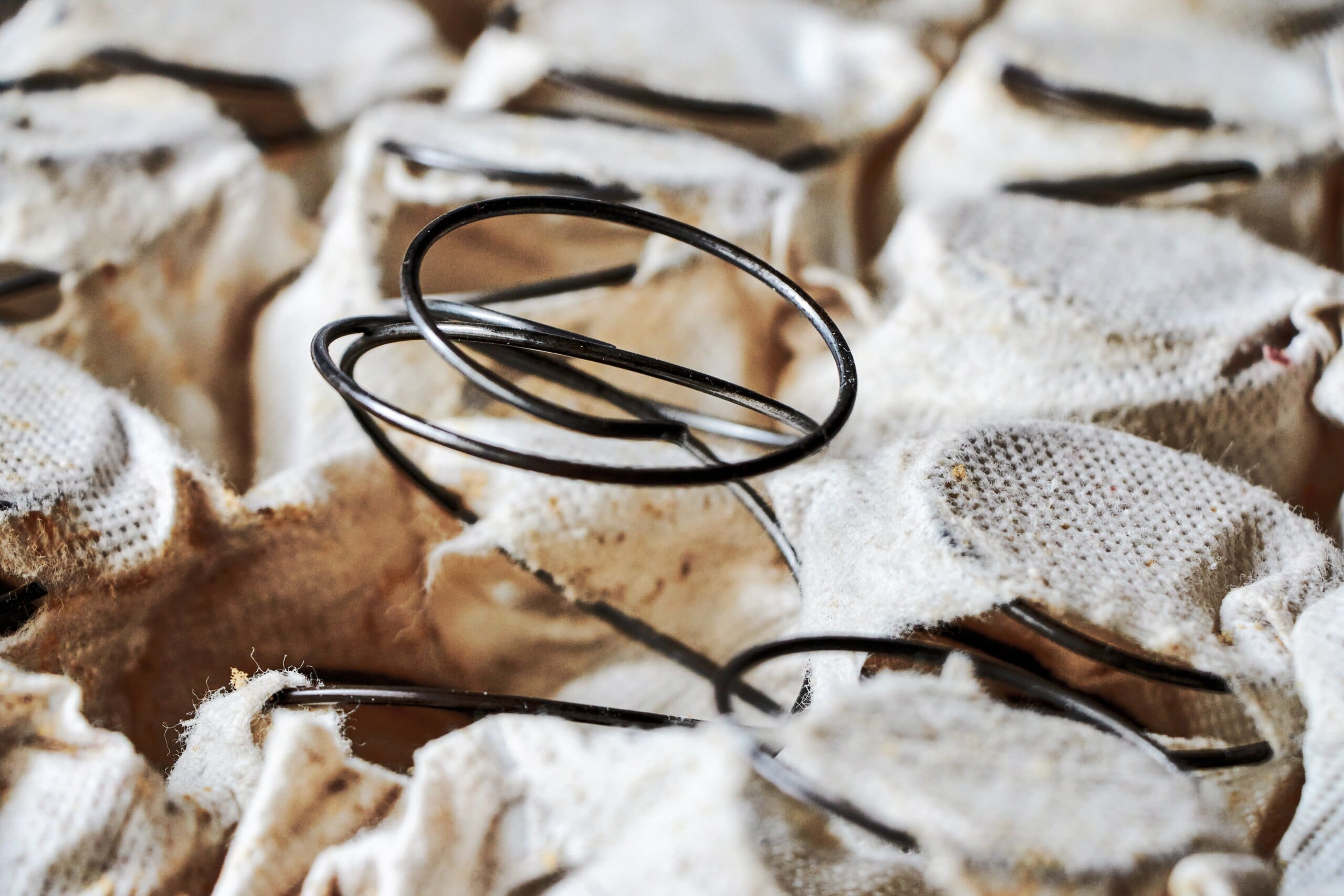Last updated: May 2025
How To Clean A Mattress
How to clean your mattress, get rid of stains and keep your bed fresh and healthy.
If you’re like most people, you rarely think about whether or not you should be cleaning your mattress regularly unless, of course, you've accidentally spilt something and left a stain.
But even though general everyday dirt and grime might not be visible on our mattresses thanks to our bedding, that’s not to say our mattresses aren’t slowly getting dirtier by the day – in fact, it’s quite the opposite!
So, whether you’ve never considered cleaning your mattress before, or you’ve just invested in a new mattress and want to maximise its lifespan by looking after it properly, we’ve covered everything you need to know about how to clean a mattress in our guide below.
Read on to learn our top tips for how to clean your mattress, get rid of deep stains, and keep your bed fresh and healthy.

How often should I clean my mattress?
Before we get started on how to clean a mattress, it’s worth knowing how often you should be doing it. After all, there’s a difference between doing a light dusting and fully cleaning your mattress from top to bottom.
So, with this in mind, most manufacturers recommend that you give your mattress a once-over at least twice a year, though there’s no harm in doing it more frequently, and many mattress experts suggest giving yours a seasonal clean roughly once every three months, as this tends to be when you'll need to flip or rotate your mattress too.
How important is it to clean my mattress?
While not an absolutely essential thing to add to your cleaning routine, the long and the short of it is that a clean mattress is just better for both your health and can help your mattress last longer.
And, naturally, cleaning your mattress comes with many benefits, including the elimination of dust mites, allergens, sweat, stray pet hairs, and other residues, helping to keep it stain-free and fresh throughout the year.
Why do dust mites love your mattress?
As anyone who has tried knows it's almost impossible to control the dust in your home. Traditional cleaning often just moves the dust from one place to another, and as 80% of household dust is made up of our dead skin, we're always producing more – it’s a never-ending cycle!
But it's in this environment that the dust mite thrives!
Practically invisible to the naked eye, dust mites feast on the dead skin we shed and flourish in warm, moist conditions. It may sound unsavoury, but we're all living in close contact with dust mites all the time.
With this in mind, it probably won’t shock you then to learn that your mattress is one of the main places that dust mites like to live. It's warm, cosy, and constantly fed with the fluid and dead skin that we lose at night.
Not only is this not nice to think about, but in many cases, it's the enzymes released in dust mite droppings that cause or inflame certain allergic reactions – particularly asthma or other associated breathing problems.
Of course, there are things that you can do to help reduce the number of dust mites in your home - although eradicating them is a huge, expensive task, and a full-time job. But even if no one in your family suffers from allergies, it's beneficial to your health to clamp down on dust mites by cleaning your mattress!
You can also read our guide to getting rid of dust mites in your home, as they love to live on your sofa and even your carpets, too, not just your bed!
What is the best way to clean a mattress?
When it comes to how to wash a mattress, there are several avenues you can take to free it from dust and contaminants. For example, you might want to take on this responsibility yourself and put the time in to clean it properly (maybe for the first time). Or you could hire a professional cleaner to do it for you instead if you have the budget for it.
If you have a foam mattress, take a look at our dedicated guide to cleaning a memory foam mattress, but if you're looking for general advice on cleaning your sleep surface, we've outlined some key points to consider.
How to clean your mattress at home
First off, if you want to start cleaning your mattress at home, we recommend taking the following steps to freshen it up without damaging its materials:
1. Caring for your mattress starts from day one
For those who’ve just bought a new mattress and want to make sure they clean it correctly, the care of your mattress starts the day it arrives. While the mattress has been constructed to give you the right level of support and comfort, in order to get from the factory to you, it has had to be wrapped and moved, perhaps more than once.
Thus, when it gets to your house, you should immediately take off all the wrapping and let your new mattress breathe. Mattresses are usually wrapped in polythene, which may encourage the build-up of moisture, so it's wise to let the fresh air circulate your mattress for a while to freshen it up.
You should also give some time for your mattress filling to settle. You can sleep on it whilst this happens, but don't be alarmed if your mattress feels slightly different after a few nights of sleep.
And if you've gone for a memory foam mattress, you should leave it to fully expand before laying on it - our guide on how long a memory foam mattress takes to expand will help you.
2. Wash your bedding regularly
As a general rule of thumb, most mattress cleaning experts suggest stripping your mattress sheets and washing your bedding once a week, as well as putting them through a hot wash once a month.
Doing this is very important as regular and hot washes like these help to get rid of any bed bugs in your bedding, as well as dust mites and other nasties, preventing them from getting a permanent foothold in your mattress and aggravating any allergies you might have.

3. Air your mattress often
Much like when you first get your mattress, airing your mattress on a regular basis is a fantastic way to eliminate dust mites and odour. Dust mites might think that your mattress is the perfect home, but cool air and light are exactly the opposite of their ideal conditions.
And not to keep harping on with this point, but make sure you air your mattress as soon as it’s delivered and continue to do so regularly throughout its life. Every morning, turn back your covers rather than making the bed to let your sheets breathe, and when you change the bed, leave the mattress to air for at least 30 minutes before putting on new sheets.
4. Vacuum your mattress
While not appropriate for all mattress types, when done carefully, vacuuming can help to remove dust and debris from your mattress that may have built up over time. You do need to watch how you hoover though, because heavy-handed vacuuming could damage the ticking or outer covering of your mattress.
Damage such as this not only compromises the support that your mattress can give you but may also invalidate your guarantee or warranty, so be as gentle as you can should you decide that vacuuming is necessary. It’s also important to note that vacuuming will not remove dust mites, but it will remove the dust and dead skin that they live on.
For the greatest impact, we suggest using a hand-held vacuum, or soft attachment head for your regular hoover, and give your mattress a quick vacuum when you change your bedding. And if you're particularly worried about dust mites and other allergens, consider a hypoallergenic mattress to help minimise their impact.
How to get stains out of a mattress
If you’re looking at your mattress and feel like a hoover won’t be enough to remove any dirt or stains present, then the next step for getting stains out of your mattress is to get your hands on some cold water (never hot!) and a mild detergent.
Ideally, you want to get stains and dirt out of your mattress as soon as they happen, not only to help keep your mattress looking its best but to also prevent the build-up of bacteria and unpleasant odours.
For blood, stains you can make a simple paste using hydrogen peroxide, salt, and cornflour, which you can read more about in our guide to getting blood out of your mattress.
As for getting urine out of a mattress or Number Two-style accidents, you can use water and detergent, before wiping it all away with a secondary solution of cold water mixed with antiseptic spray.

How do I sanitise a mattress?
Slightly different from cleaning your mattress, sanitising your bed is all about getting it disinfected for a full refresh, or after you or someone else has used it during a period of illness, to give it a new lease of life:
1. Vinegar Spray
The acidity in vinegar acts as a superb deterrent against dust mites, and mixing some with water and a few drops of essential oil of your choice will leave your bed smelling fresh. We recommend lavender for a sleep-enhancing scent, or teetree oil, which is a smell that bed bugs hate.
Better yet, while vinegar helps repel dust mites, it also breaks down the proteins in their droppings, which are responsible for the allergens that many sleepers react to. Distilled white vinegar is best and the solution should be sprayed, rather than poured, over the whole mattress.
2. Sanitising stains
As you may already know, stains left unchecked that hold a lot of moisture can eventually lead to the growth of mildew, which you obviously want to avoid if possible. This is because some mildew produces mycotoxins which, especially if you are trying to sleep with asthma, can become a health hazard.
Fortunately, a mattress stain remover should be enough to do the job. However, you can also create your own deep-cleaning stain sanitiser with 60ml of hydrogen peroxide, one tablespoon of cold water, one tablespoon of salt, and one tablespoon of liquid soap.
Apply this to the required area and leave it to dry. Once dried, the residue can be scraped off and then wiped down with a cloth dipped in hydrogen peroxide to get rid of the last remnants of any staining.
3. Use bicarbonate of soda
If you’re anything like us, you might be keeping an eye out for any online hacks out there on how to clean your mattress with bicarbonate of soda. And although it’s found its place on the Internet, this tip has been used for decades to freshen up mattresses that may smell a little past their sell-by date.
The trick is to sprinkle yours with bicarbonate of soda and leave it for a few hours. Bicarbonate of soda is incredibly absorbent and will soak up sweat residue and associated odours. After a few hours, simply vacuum your mattress clean and you’ll be left with an odourless mattress ready for fresh sheets.
5. Break out the vodka
Finally, if you’re after more tips on the question “How do you clean and sanitise a mattress?”, you may want to head for the drink’s cupboard at the earliest opportunity! This is because vodka has long been used as an antiseptic around the house, and the good news is that it can be equally effective on your mattress.
Naturally, there’s no need to use top-of-the-range stuff; anything cheap and cheerful will do. Simply pour some into a spray bottle and spray your mattress, before leaving it to dry. Alcohol evaporates quicker than water, so it will dry completely in a fairly short time.
And if you’re worried about the odour of alcohol, which should be minimal, you can add a few drops of your favourite essential oil to the spray bottle in order to mask any potential scents left behind.
Cleaning a mattress: Hiring professional help
If, despite all our tips, you’re at a loss as to how to wash your mattress, or things have gotten a little bit out of hand, then there’s always the professional cleaning route for those whose mattresses are too filthy to tame by themselves.
Basically, using a professional mattress cleaner is a good idea for mattresses in serious need of rescuing. They’ll use steam cleaners and UV lights to kill any dust mites and break down allergens before giving your entire mattress a full disinfecting to eliminate as much staining as possible.
However, do bear in mind that this can be an expensive undertaking, and you might actually find it more cost-effective to buy a new replacement mattress instead, especially if you’ve had your mattress for several years.




How to keep your mattress in good condition
Last, but not least, when it comes to keeping your mattress clean, prevention is better than the cure. With that in mind, here are our top tips for how to keep your mattress in good condition to minimise cleaning:
- If your mattress requires turning, don't forget to turn it. Some mattresses only require rotating rather than turning, and your care instructions should tell you how often you need to do this.
- Don't fold your mattress, even if you're storing it. If you’re looking for a mattress to store before use, consider a rolled mattress. These come rolled tight into a box and take up the least amount of room.
- Only use mild detergent and non-harsh cleaning equipment to remove stains from your mattress and avoid soaking it where possible.
Don't smoke in bed
Whilst all mattresses should have been tested to British Standard 7177, which covers the flammability of mattresses and other furniture, it's still inadvisable to smoke in bed – both to prevent ash and burn marks and ignite your mattress material.
The risks of falling asleep with a lit cigarette are well documented by the Fire Service. And as you're already sleeping, you could be very susceptible to the toxic smoke that could be released by your bedding or your mattress. It's far safer to restrict your smoking to other parts of your house or, even better, outside.
Don’t ignore exposed springs
If your mattress is coming to the end of its life, you may find that the ticking is threadbare, or that you can feel the springs through the mattress cover. Don't ignore this - start looking for a new mattress.
Exposed springs and leaking filling can be dangerous both to adults and children, and it's best if your mattress doesn't get into this state at all. But if it has, it's definitely time for a new one.
Share the load when turning your mattress
Many mattresses still require flipping over regularly to keep their filling evenly distributed and to vary the load on the springs. And given their filling, most mattresses are very heavy, so you shouldn't attempt to turn one by yourself if possible.
Not only can the size and weight of your mattress mean that you could damage your back, shoulders or neck, but if done improperly, you could also damage your bed frame by accident.
So, if your mattress needs to be turned, always ask for help. And if you think you could have a problem finding someone to help, think about buying a non-turn mattress, which only needs to be rotated from head to foot.

How to protect your mattress from getting dirty
It's generally accepted by mattress experts that protecting your mattress is one of the best ways to ensure it lasts as long as possible. Whether you're protecting a child's mattress during toilet training or protecting your own mattress against wear and tear, it's worth investing in a little extra protection:
Mattress Toppers
If you want to protect your mattress from stains and other external damage, invest in a mattress topper. Not only are they often padded for extra comfort but they’re easy to wash too.
Mattress Protectors
Offering greater protection than toppers, mattress protectors are designed to lengthen the life of your mattress. From waterproof protectors to those that prevent dust and mites, a protector is highly recommended for any bed.
Waterproof toppers and protectors
Waterproof covers are essential for children who are toilet training or having bed-wetting problems, as failing to protect your mattress in this way could lead to problems with the mattress ticking and filling and shorten the life of your mattress.
A good child's waterproof cover protects the mattress against wetness and odour and can be easily cleaned, making the process as hassle-free as possible, and there’s also a wide range of waterproof covers available for adults who need to protect their mattresses because of light or heavy incontinence.
Allergy protectors and toppers
Whilst a specially treated allergy cover cannot combat a dust mite problem by itself, it can help to reduce the number of allergens that are released into the air we breathe every time we turn over in bed or move around our room.
Available for all sizes of beds, including cots, and also available for pillows, an anti-allergen cover may be the first step to improving your health while sleeping.
Find an easy-to-clean mattress in our range
With all of our points covered, you should hopefully now have a much better idea of how to clean a mattress in the future.
With that being said, even with a good mattress cleaning routine, it can sometimes be hard to determine exactly when the best time to replace that old mattress with a new one is.
If you know you want to replace your mattress but don’t know where to start, our MattressFinder™ quiz will help you find a new mattress that's perfectly suited to you in just a few simple clicks!

